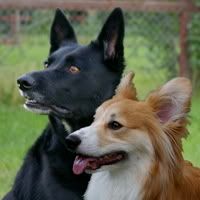There are several different dog behaviors that are considered "rude" in the human world that can be prevented easily at an early age. I just wanted to share some methods that I have used.
-Jumping Up
One of the easiest and most effective ways to prevent a dog from learning to jump up is simply to ignore from the beginning. If the dog jumps up, pretend he doesn't exist. Take your hands away, and look somewhere else. Stand up if you have to. What the dog is looking for is attention, so don't give in. Even telling the dog "NO" is attention.
As soon as the dog puts all four feet back on the ground, give lots of praise. He will quickly learn that jumping up gets absolutely no reaction from you, and isn't worth trying, but if he has all four feet on the ground, he gets all kinds of love and attention! Teaching the dog not to jump up can take weeks to months from puppyhood if you are consistent.
-Chewing Inappropriate Objects
Two great methods for preventing chewing from becoming a bad habit is confining the dog when he's not being supervised, and catching him in the act of chewing so that you can trade the the wrong object for the right one.
Crating is a great way to prevent your dog from getting into things he shouldn't when you're not around. It can also prevent him from getting into dangerous situations, such as being tangled in wires, eating toxic things, and many other dangerous things young, untrained dogs tend to do when they're alone.
When the dog is out, and you catch him chewing on something he shouldn't, you can get his attention with a sharp "Ah, Ah!" or something similar. Try to get him to trade for the right object, such as a chew toy, by holding it up for him so that he stops chewing the inappropriate object and goes for the toy. When he lets go of the inappropriate object, you can also say "Trade ya!" before you let him have his toy. This exercise can also teach another valuable tool - trading for another object - which can help to prevent resource guarding in the future.
One other thing I must mention is that you should ALWAYS have lots of things for the dog to chew on, no matter what age he is! Dogs never just grow up and stop chewing. They need to chew throughout their lives.
Teaching a dog to chew on the RIGHT things can take a lot of time and consistency, but don't give up!
-Getting Into Trash
There is a VERY simple solution for this, and I don't understand why people refuse to do it - Get a covered trash can, or put your trash in a cabinet, or behind a gate or door where your dog cannot access it! Out of sight, out of mind!
-Excessive Barking
Play sessions are a great way to help prevent unwanted barking. While you are playing with your dog, be it tug or fetch, or whatever his favorite game is, pay attention to how loud he's being. If he starts barking, you can immediately get up, put the toy out of reach, and end the play session for a few minutes. This is a very quick and humane way to teach the dog that if he starts barking, it causes you to quit playing with him. It really does help to curb a lot of unnecessary barking in the long run.
All articles on this blog are written by Victoria Steen unless otherwise stated. They are NOT to be redistributed.
Subscribe to:
Post Comments (Atom)

No comments:
Post a Comment